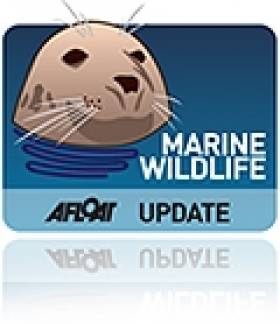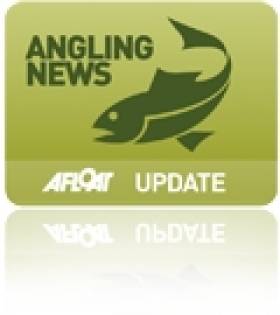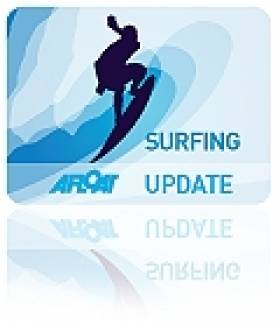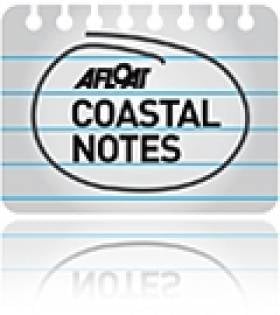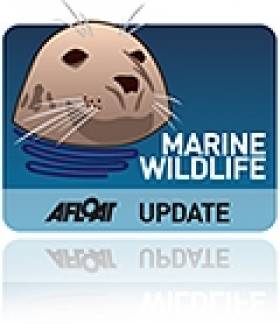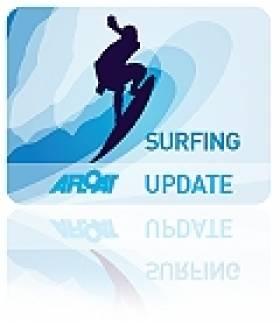Displaying items by tag: Kerry
White-Tailed Sea Eagles Found Dead in Southwest
#MarineWildlife - RTÉ News reports on the discovery of two dead white-tailed sea eagles in Kerry and West Cork.
The bird found washed up near Glengariff in West Cork two weeks ago was confirmed as poisoned after a post-mortem at the State Laboratory in Celbridge.
According to its electronic tag, the female sea eagle was released in Kerry more than two years ago.
Meanwhile a second bird found in south Kerry earlier this week is also believed to have been died as a result of eating poisoned carrion - an illegal method sometimes employed to control crows and foxes preying on lambs.
A protected species under Irish law, some 100 while-tailed sea eagles were reintroduced to the wild in Killarney National Park from 2007 to 2011. Since that time more than a quarter have been found dead, with 12 of those cases confirmed as poisonings.
Windsurfers Race to Kerry for Red Bull Storm Chase
#Windsurfing - Due to 2012's calm storm season, organisers of the Red Bull Storm Chase recently extended the competition into this year - and competitors are currently racing to Ireland for the first mission of the contest.
Brandon Bay in Kerry was decided as the spot early this morning, and the competition is scheduled to begin just after sunrise tomorrow (Monday 28 January) when stormy weather conditions are expected to be at their peak.
The Red Bull Storm Chase website has live updates from competitors making their way to Kerry from as far away as the Marshall Islands in the Pacific Ocean.
Ten windsurfers chosen by community vote will take part in the first mission, with the top six going on to the second mission some time before 22 March at any one of seven possible destinations around the world, most of which have not before taken centre stage on the windsurfing scene.
Sadly no Irish windsurfers will be competing this time round, but names the likes of Timo Mullen and Dan Gardner on the shortlist will surely be keeping an eye on the competition as they get set to chase the ride of their lives.
IFI Repeats Concerns Over Aran Islands Fish Farm
#Angling - Anglers on the River Feale in Kerry and Limerick have been assured by Inland Fisheries Ireland (IFI) that it supports their concerns over the proposed deep-sea fish farm in Galway Bay, as the Limerick Leader reports.
Local anglers are among those throughout the region who have rallied in opposition to plans for the Aran Islands fish farm project, over fears that it would lead to “an explosion” in parasitic sea lice which would prey on wild inland salmon from Irish rivers feeding in the North Atlantic.
IFI reiterated its statement issued last month in which its board said it does not believe "that the corpus of peer reviewed international scientific literature which recognises the negative impacts of sea lice on salmonids have been adequately dealt with" in the Environmental Impact Statement prepared by Bord Iascaigh Mhara (BIM) as part of the public consultation process.
A spokesperson for IFI told the Limerick Leader that the authority has "major concerns about the location and scale [of the farm], as well as its potential impact on sea life. [IFI] is not supporting it in its current form.”
Earlier this month the National Inland Fisheries Forum also criticised as "flawed" the consent process regarding the 15,000-tonne organic salmon farm planned off Inis Oirr, which would be the largest of its kind in Europe.
If approved, the operation could more than double Ireland's current production rate of farmed salmon.
The Limerick Leader has much more on the story HERE.
Cold Water Surfers Catch The Waves At Brandon Bay
#Surfing - Check out this beautifully shot video from ONITmedia of intrepid winter surfers catching the breaks at Brandon Bay, Co Kerry.
The waves might not be the biggest that Ireland has to offer at this time of year - for those the wet-suited warriors head to Mullaghmore - but the stunning scenery, not to mention the surprise appearances by local cetaceans, more than make up for it.
Twitter Fears Unfounded as Dingle's Fungie is Alive and Flipping
#FUNGIE - He was the subject of rumours of his demise earlier this week - but the people of Dingle say their most famous resident, Fungie the dolphin, is alive and flipping.
A spokeswoman for Dingle Dolphin Boat Tours confirmed to The Daily Edge that Fungie is "definitely alive", and that no dolphin remains had washed up on the beach, as had been claimed on Twitter last Monday morning.
The Co Kerry fishing village is celebrating 30 years of the bottlenose dolphin's residency in its harbour. It's unclear exactly how old Fungie is, but it's presumed he was born in the mid 1970s.
Irish Central has more on the story HERE.
Oil Field Off Kerry Could Produce One Billion Barrels
#KERRY OIL - Oil exploration firm Petrel Resources has announced it has found as much as one billion barrels of oil off the coast of Co Kerry.
The Irish Independent reports on the findings by the Dublin-based company which show enormous reserves of oil in the Porcupine Basin off the south-west coast.
As previously reported on Afloat.ie, the company said in September that it has identified a number of targets across the more than 1,400 sq km area of the Atlantic Ocean west of Dursey Island.
Technical studies conducted then on blocks in the northern and eastern parts of the basin for reservoir sands were described as "encouraging".
Now Petrel says that computer analysis shows several oil fields stacked in layers that could be tapped by a smaller number of oil wells.
The distance from shore - approximately 200km - plus the location of the oil reserves beneath 1km of water and a further 3km of rock present some difficulties, but new techniques in the oil industry are allowing previously undrillable resources to be extracted.
Petrel Resources is seeking a partner to invest in drilling for oil, and is preparing its application to the Government for a licence.
The Irish Independent has more on the story HERE.
Thirty Years of Fungie's Frolics in Dingle
#FUNGIE - A new video posted to YouTube celebrates 30 years of Fungie the dolphin in Dingle.
The male bottlenose dolphin appeared from out of nowhere in the Co Kerry fishing village in 1983 and soon made it his home, quickly becoming an integral part of the local community.
Since his arrival Fungie has made friends and warmed hearts with people both local and across the world, such as Dutch couple Jeannine Masset and Rudi Schamhart who have been meeting him for more than 20 years.
Meanwhile, locals hope that new measures for harbour users proposed earlier this year won't bring an end to boat trips to meet Dingle's most famous resident.
Kerry Harbour Users Say No to Over-Regulation
#IRISH HARBOURS - Protesters took to the water off Kerry's piers last month in an organised swim drawing attention to proposed harbour bylaws designed to regulate the activities of water users.
“We need to make the public aware they have to make submissions,” Denise Collins told The Irish Times from Kells, which hosted one of the largest swims. “Traditional activities such as swimming will be over-regulated, we fear.”
The proposed bylaws would give Kerry County Council greater control over 16 of the county's 57 harbours and piers, including Kells, Kenmare, Portmagee, Brandon and Ventry.
Under the new bylaws, strict regulations would be placed on the use of loudhailers, landing and unloading passengers and freight, waste and even movement around the harbour.
"Draconian" charges are also set to be imposed on fishermen and other harbour users, while campaingers also feel that a ban on swimming and diving could also be added to the list.
The proposed bylaws already suffered a set-back earlier this year when Kerry County Councillors decided to restart the consultation process to allow the fishing industry, tourism operators and other interests more time to make submissions.
According to the Irish Examiner, only two submissions had been received by the council as of its January monthly meeting, despite senior council officials working for months on the draft proposals.
Cllr Toiréasa Ferris commented that the proposed charges in particular "would have huge implications for fishermen, some of whom might currently be earning only between €40 and €50 for a 14-hour day."
As previously reported on Afloat.ie, charges may also soon be hiked on yachts berthing at Ireland's main fishing harbours, a list that includes Dingle in Co Kerry.
Irish Marine Federation chairman David O'Brien expressed concern at the potential for such charges to damage "the good tourism dividend for coastal towns", noting that for every euro spent on a harbour berth, €10 was normally spent in the locality.
March's Big Waves Tease a Wild Summer of Surfing
#SURFING - Irish surf classifieds website Surfseekers.ie has compiled some stunning images from March's world-class surfing conditions.
From the biggest rollers in years off Mullaghmore Head in Co Sligo to the Cliffs of Moher and even as far south as Kerry, Ireland has seen some of its best surf in a long time - and things are certainly looking up for an exciting summer on the waves.
Three Opportunities for Lakeside Living
#WATERFRONT PROPERTY - The Irish Times features a selection of serene lakeside properties to suit a variety of tastes and budgets.
Urrahill in Ballycommon, Nenagh, Co Tipperary is a detached home overlooking Luska Bay and Lough Derg and comprising three levels.
The upper level features living rooms and a kitchen with large windows and stunning views. The middle level has four bedrooms, with the main en-suite on the lowest floor with sliding doors to a private terrace.
Colliers International is asking €1.5 million for this ultra-modern property.
Meanwhile in Kerry, a four-bed country house on 1.5 acres is less than a mile from Waterville yet features its own pier with boathouse on Lough Currane, known for its salmon and trout angling.
The house has central heating throughout, oak flooring, a lounge with its own wood-burning stove, a fully fitted kitchen, car garage and utility shed. Kerry Property Services is asking €580,000.
Last but not least, those looking to renovate would surely be attracted to Eden Point in Rossinver, Co Leitrim, a two-bed, two-bathroom detached home on the shores of Lough Melvin.
Eden Point boasts "hundreds of metres" of foreshore, as well as a boat house and quay, and included in the sale is a share in the Rossinver Fishery Sundicate (worth €5,000) which allows free use of the Rossinver Fishery. Fermanagh Lakeland Properties is asking €250,000.



























